





BUU76.jpg (taken 26.6.2011)
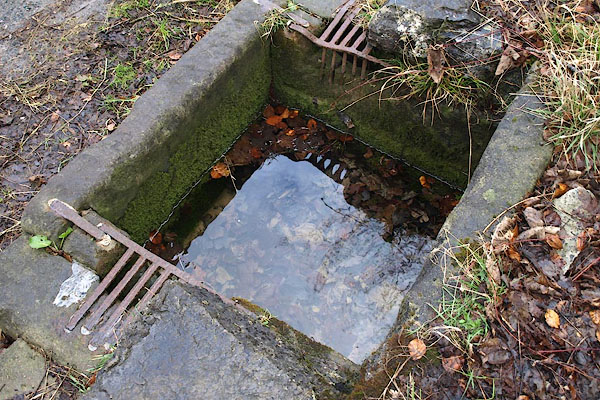
BOT67.jpg (taken 7.3.2008)
 goto source
goto sourcePage 27:- "..."
"Thence to Giggleswick most steril,"
"Hemm'd with Rocks and Shelves of Peril:"
"Near to th' Way as a Traveller goes,"
"A fresh Spring both ebbs and flows:"
"Neither knows the Learn'd that travel,"
"What procures it, Salt or Gravel."
 goto source
goto sourcePennant's Tour 1773, page 113 "The famous flowing spring lies on the road side beneath this scar. It is a well of small size, which ebbs and flows once in a quarter of an hour, and sometimes with that force as to rise a foot high. I watched it for some time, but it happened to be quiescent: my patience was exhausted and I pursued my journey."
"The Potentilla verna, or Vernal Cinquefoil, Fl. Sc. 1, 270, is found near this well; and those who delight in mosses, may discover, on the adjacent rocks, the Lichen crinitus and polyrhizos Fl. Sc. 11, 860 and 864."
"..."
 goto source
goto sourcePage 381:- "The properties of springs or wells which reciprocate at short intervals, may be accounted for in a plausible manner upon the principle of the syphon. There is a well near Giggleswick in Yorkshire, very remarkable for its alternations, which are performed in a small bason or reservoir, placed over the spring. The water after subsiding ten or twelve inches, returns to its former height in much less time, and the alternate accumulation and diminution occurs several times in the course of an hour, when the season is neither very wet nor very dry; but after much rain, or long continued draught (sic), the reciprocations are very variable and uncertain in their returns."
"One very plausible manner of accounting for the settled alternations of such a well, when the water subsides much slower than it accumulates, is the following."
the relevant plate is tipped in opposite p.191:-
 click to enlarge
click to enlargeWS2703.jpg
"Let Fig.8. in Pl.V. represent the section of the rock where the spring is situated, and which contains the natural apparatus producing the alternations in the bason. B is a cavity, receiving an equable supply of water, through a small crevice or apperture at A. C is a crooked passage or natural syphon in the rock: its higher end opens into the cavity B, and its lower is situated over an open bason or cavity D, which, by a wide descending pipe or passage, communicates with the well E. The bottom of the well E terminates in a small duct or passage F, through which the water descends from the well into a lower situation."
"If the small stream from A, after filling the cavity B, be sufficient to fill the syphon C, the descending column being considerably longer than the ascending one, the current through the syphon being accelerated by the pressure of the atmosphere, rendered active on the surface of the water in B, by the impending effect of the descending column in the syphon, the water in the cavity B, independent of the supply, will rapidly subside to a level with the higher orifice of the syphon: when a quantity of the air being taken into that pipe, its operation will cease, until the cavity is again"
 goto source
goto sourcePage 382:- "filled by the spring. Every time that the syphon empties the cavity, the water, being rapidly poured into the bason D, and descending by the passage below, will rise in the well E, until the cessation of the operation of the syphon: and then it will subside by running off at the outlet at the bottom of the well, until the syphon begins again to empty the superior cavity: and in this manner the alternations in the well will continue, so long as the spring at A affords a proper supply. When there is too much, the syphon will always be full, and the well below will always overflow: when there is too little, the syphon will never be filled, but only transmit the water as fast as it comes, consequently, the well will always be nearly empty. If the cavity B, be contracted in its higher part here it is on a level with the turn of the syphon, more regularity will occur in the alternations, and a smaller supply will fill the syphon, and make it emit a full stream sooner, than would suffice if the cavity was every where of the same width."
"..."
item:- private collection : 202.4
Image © see bottom of page
 goto source
goto sourceTour to the Caves in the West Riding of Yorkshire, late 18th century
Page 276:- "..."
"About a quarter of a mile before we arrived at Settle, we turned to the right, along the road towards Kirkby-Lonsdale, about a mile, under the high and romantic rocks called Giggleswick-scar, in order to see the well by the way-side, that ebbs and flows. We were in luck, seeing it reciprocate several times while we were there, and not staying above an hour. We could not however learn with any degree of certainty, by what intervals of time, and to what heights and depths, the reciprocation was carried on. We were informed, that if the weather was either very droughty or very wet, the phenomenon ceased. I have seen some philosophical attempts to solve this extraordinary curiosity on the principle of the syphon, but in vain; as, on that hypothesis, if the syphon is filled by the spring, it will flow on uniformly for ever. We were told by drunken Barnaby, an hundred and fifty years ago, that it puzzled the wits of his age.-"
 goto source
goto sourcePage 277:- "Veni Giggleswick, parum frugis / Profert tellus, clausa jugis: / Ibi vena prope vioe / Fluit, refluit, note, die; / Neque norunt unde vena, / An a sale vel arena."
"Thence to Giggleswick, most steril, / Hemm'd with shelves and rocks of peril. / Near to the way, as a traveller goes, / A fine fresh spring both ebbs and flows: / Neither know the learn'd that travel, / What procures it, sand or gravel."
L8200247.txt
Lonsdale Magazine, 1820, vol.1 pp.247-248
page 247:- "THE PHILOSOPHER."
"GIGGLESWICK WELL."
"To the Editor of the Lonsdale Magazine."
"SIR,"
"As the ebbing and flowing well by the road side under the high and romantic rocks called Giggleswick Scar, near Settle, is an object of general curiosity to the passing traveller, and as the principles upon which the phenomena"
L8200248.txt
page 248:- "of ebbing and flowing wells are at present explained are perhaps not very generally known, the following short account may not be unacceptable to your readers."
"The water in its passage through the rock meets with a pretty large cavity or reservoir from which it escapes through a long and narrow aperture near the bottom, in shape like the tube of a siphon, and so to the well."
"Now the water as it is filling the reservoir will also rise in that leg of the siphon to which it has communication, till it reach the top of the bend; the stream will then by its gravity descend down the other leg, and set it a running."
"The siphon by discharging a greater quantity of water in a given time than what the stream supplies, will cause it to descend in the reservoir till it let air into the siphon which will make it empty itself and stop running. When the siphon has ceased to run, the water will again rise in the reservoir and leg of the siphon till it is set running as before."
"If the weather is very wet or very droughty the phenomenon ceases; when the former is the case it may be accounted for by supposing the stream to run into the reservoir as fast as the siphon can empty it; but when the latter is the case it can only be accounted for on the supposition that there is another small opening as well as the siphon through which a portion of the water in the reservoir makes its escape, and when the spring is weak the whole is discharged through this second aperture."
"The figure annexed will more fully illustrate what has been said."
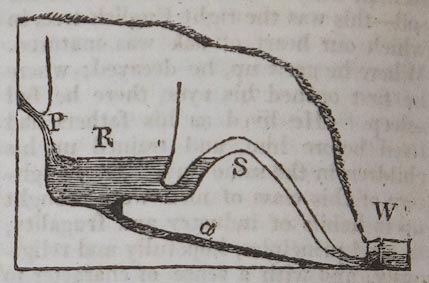
L820E01.jpg
"P. The passage by which the water enters the reservoir."
"R. The reservoir filling before the siphon begins to run."
"S. An aperture in the shape of a siphon through which the greatest part of the water escapes from the reservoir."
"a. A second small aperture by which the whole of the water escapes in droughty weather."
"W. The well at ebb, which as soon as the siphon commences running will begin to flow, and when the siphon is stopt will ebb again."
"F-J-R-"
"April 3d. 1820."
placename:- Ebbing and Flowing Well
 goto source
goto sourcePage 206:- "... the Ebbing and Flowing Well: of which Barnaby sang -"
""
"Ibi vena prope viae"
"Fluit, refluit, nocte, die;"
"Newque norunt unde vena,"
"An a sale vel arena."
 goto source
goto sourcePage 207:- ""
"Near to th' way as a traveller goes,"
"A fine fresh spring both ebbs and flows;"
"Neither know the learned that travel."
"What procures it - salt or gravel."
"Since those days, this phenomenon has been attributed not to 'salt or gravel,' but to the action of a syphon which Nature herself has constructed in the cliffs above. ..."
placename:- Ebbingwell
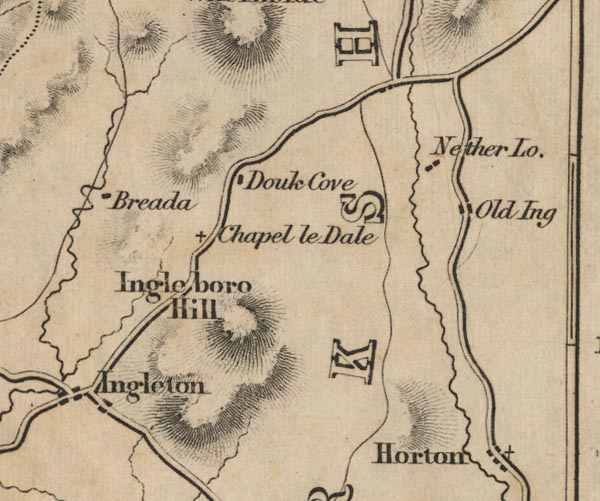
FD02SD77.jpg
"Ebbingwell"
item:- JandMN : 100.1
Image © see bottom of page
placename:- Flowing and Ebbing Well
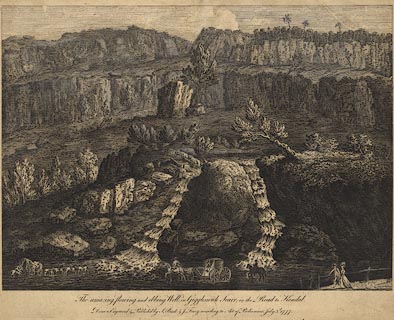 click to enlarge
click to enlargeBNF21.jpg
item:- Dove Cottage : Lowther.34
Image © see bottom of page
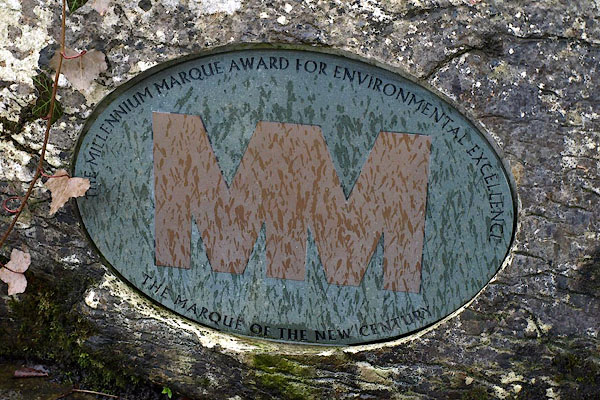
BOT68.jpg The well has a plaque:-
"THE MILLENNIUM MARQUE AWARD FOR ENVIRONMENTAL EXCELLENCE / MM / THE MARQUE OF THE NEW CENTURY" which begs a lot of questions - this site is hardly excellent.
(taken 7.3.2008)
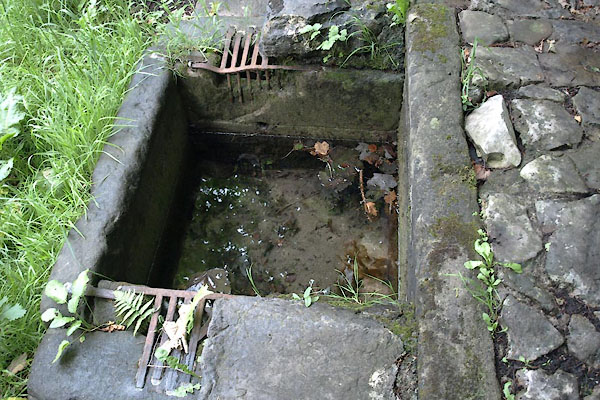
BUU77.jpg The cistern.
(taken 26.6.2011)
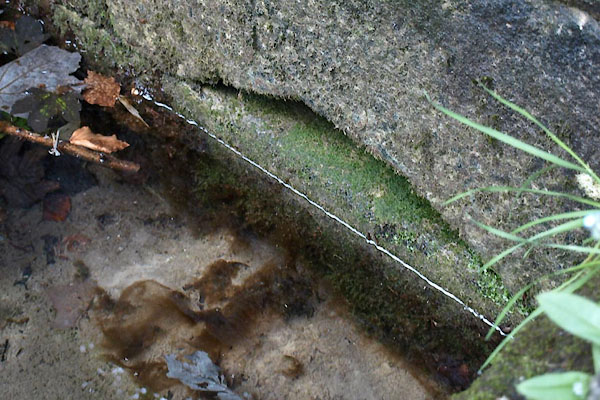
BUU78.jpg Low level.
(taken 26.6.2011)
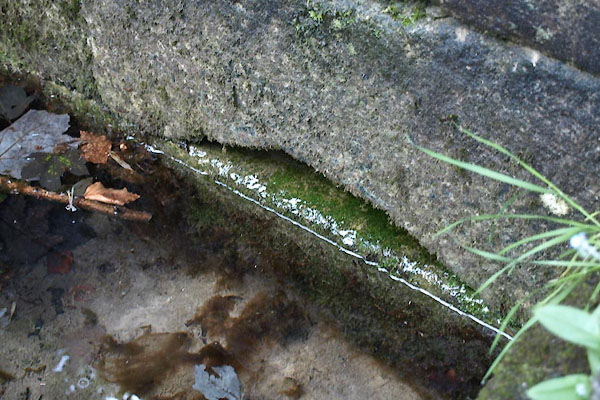
BUU79.jpg High level, water just flowing over the cill.
(taken 26.6.2011)
